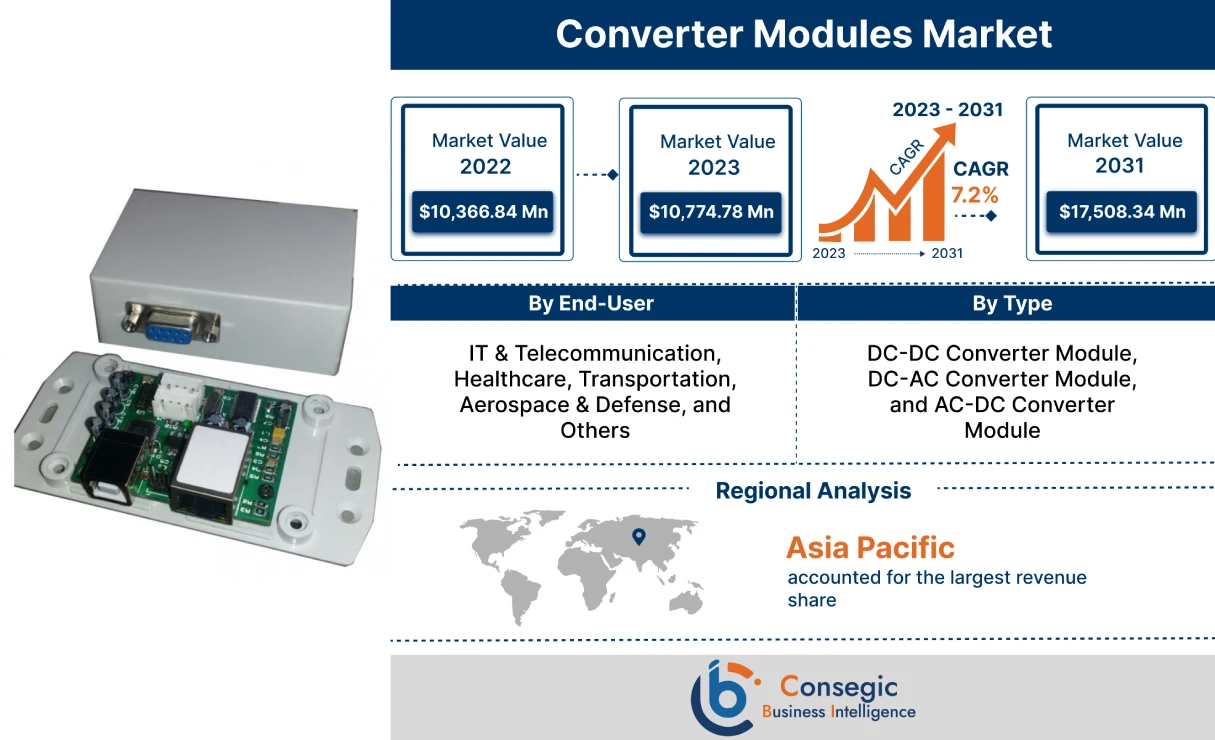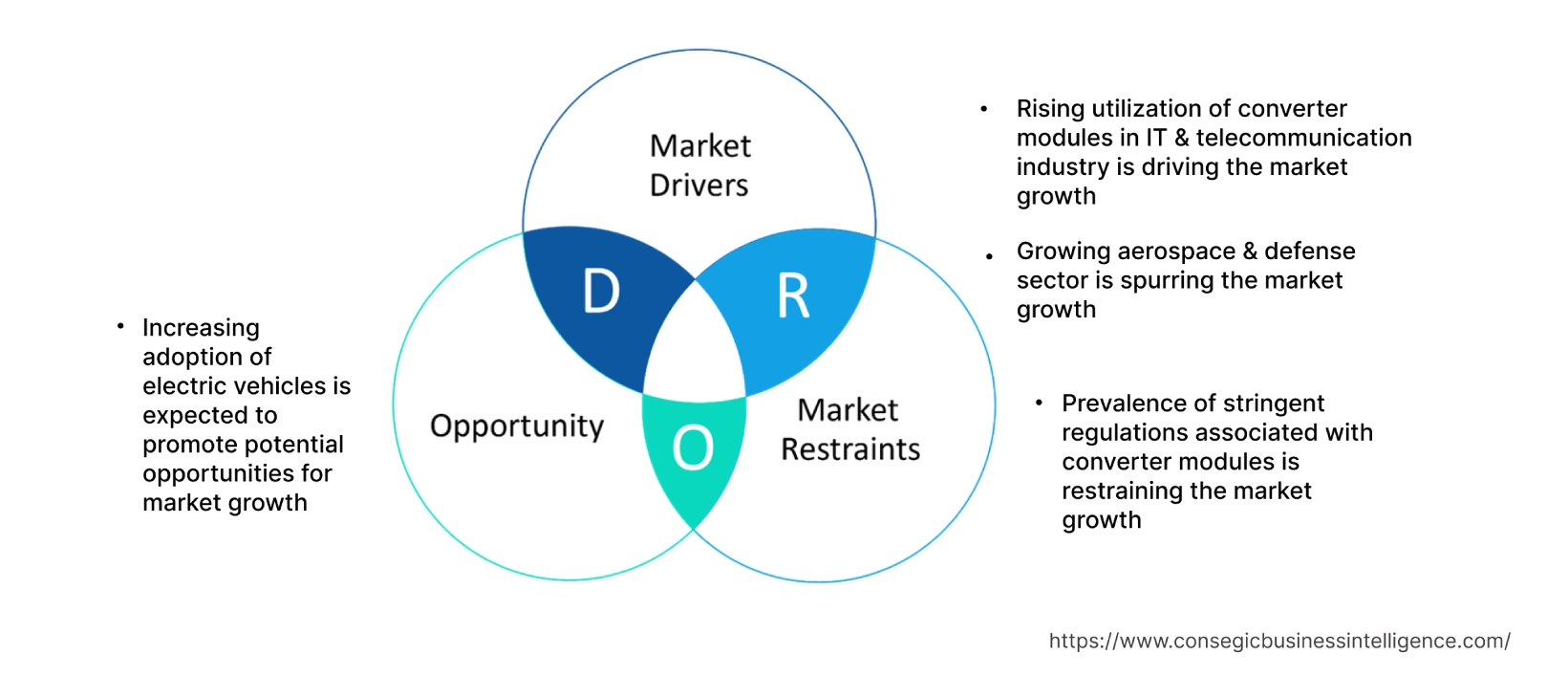- Summary
- Table Of Content
- Methodology
Converter Modules Market Size :
Converter Modules Market size is estimated to reach over USD 17,508.34 Million by 2031 from a value of USD 10,366.84 Million in 2022 and is projected to grow by USD 10,774.78 Million in 2023, growing at a CAGR of 7.2% from 2023 to 2031.
Converter Modules Market Scope & Overview:
Converter modules refer to electrical devices that are designed for converting electricity from one form to another. Converter modules enable the current to be supplied in a precise manner with an accurate voltage to a broad range of loads. Moreover, converter modules offer several characteristics including reverse polarity protection, high temperature protection, improved voltage and current regulation, high power density, and others. The aforementioned benefits of converter modules are key determinants for increasing the utilization in IT & telecommunication, healthcare, transportation, aerospace & defense, and other industries.
Converter Modules Market Insights :
Key Drivers :
Rising utilization of converter modules in IT & telecommunication industry is driving the market growth
Converter modules including AC-DC converter modules are primarily utilized in servers and telecommunication infrastructures for increasing system efficiency and improving power factor to ensure continuous operations and enhance system or device reliability. Moreover, DC-DC converter modules are used in the data centers for direct current voltage conversion to provide stabilized voltage for powering servers and systems to support the expansion and evolution of cloud services. Converter modules play a crucial role in the telecommunication industry for providing a stable voltage to several communication devices that are used to offer telecommunication services including the Internet and telephone. The characteristics of converter modules including high efficiency integrated with a high power density, high reliability, low mechanical profile, and the ability to withstand harsh outdoor operations are primary determinants for increasing the utilization in the IT & telecommunication sector.
Factors including the growing deployment of 5G infrastructure, expansion of data centers, and increasing demand for high speed communication and cloud services are among the key prospects driving the adoption of converter module. For instance, Telefonica, a Spanish multinational telecommunications company deployed its 5G services to approximately 1,400 municipalities in Spain in 2022, with the aim of reaching 2,400 municipalities by the end of 2023, depicting an increase of 71.4%. Telefonica has installed 700MHz 5G base stations with for serving 700 towns and cities throughout Spain as of February 2022.
Thus, the expansion of 5G infrastructure along with the growth of telecommunication sector are increasing the adoption of converter modules for its application in 5G base stations, data centers, and advanced communication systems, thereby, driving the growth of the market.
Growing aerospace & defense sector is spurring the market growth
Converter modules are utilized in the aerospace & defense sector for providing efficient power distribution, superior power system performance, and connectivity from multiple unregulated power sources to the point of load. Converter modules offer a stabilized and reliable power for aircraft power systems including processors, displays, along with communication and navigation electronics. Moreover, converter module for aerospace & defense industry are designed to meet precise electrical performance such as power efficiency and output, along with physical performance including size and weight and environmental performance requirements including temperature, altitude, and vibrations. The aforementioned features of converter modules are further increasing its adoption in the aerospace & defense industry.
Factors including rising commercial flight activities, increasing aircraft production, and rising investments in defense aircraft are primary determinants for driving the growth of the aerospace & defense sector. For instance, in December 2022, Dassault Aviation launched its new Rafale fighter aircraft for its application in the French military procurement agency called the Directorate General of Armaments.
Furthermore, Airbus delivered 661 commercial aircraft in 2022, witnessing a growth of 8% as compared to 611 deliveries in 2021. Hence, the growth of aviation and defense sector is increasing the adoption of converter modules for power conversion application to provide stable and reliable voltage to aircraft power systems including processors, displays, and communication and navigation electronics. The above-mentioned factors are further proliferating the growth of the market.
Key Restraints :
Prevalence of stringent regulations associated with converter modules is restraining the market growth
The manufacturers of converter module have to compulsorily comply with various stringent standards such as International Electrotechnical Commission (IEC) standard, MIL-STD (Military Standard), and others, which is a prime factor restricting the market growth.
For instance, IEC 62477-1:2022 is applicable to power electronic converter systems, any specified accessories, and its components for electronic power conversion and electronic power switching, including the medium for its control, monitoring, protection, and measurement.
Further, converter modules designed for aerospace & defense applications must comply with MIL-STD-1275, MIL-STD-704, and MIL-STD-1399 standard. MIL-STD is a military standard that outlines a standardized power interface between military aircraft and its equipment and also provides general guidance information on compliance tests, aircraft electrical operating conditions, power groups, and utilization equipment specifications among others. Therefore, the prevalence of the aforementioned regulations and standards associated with converter modules are restraining the growth of the market.
Future Opportunities :
Increasing adoption of electric vehicles is expected to promote potential opportunities for market growth
The increasing adoption of electric vehicles is expected to present potential opportunities for the growth of the converter modules market. In electric vehicles, the utilization of motors is primarily driven by AC current whereas the majority of the vehicle is usually powered by DC. Moreover, converter modules play a vital role in converting direct current (DC) from one voltage level to another for providing a reliable power source for in-car entertainment system and battery management system along with other EV components including headlights, radio, and other ancillary equipment in electric vehicles.
Factors including the availability of a wide range of models, eco-friendliness, along with the accessibility of subsidies and tax rebates are driving the adoption of electric vehicles. For instance, according to the International Energy Agency (IEA), the global adoption of electric cars witnessed strong growth in 2022. IEA states that the global sales of electric vehicles reached 2 million units in the first quarter of 2022, depicting an increase of 75% as compared to the first quarter of 2021.
Additionally, according to the European Environment Agency, the total electric car registrations in Europe reached approximately 1.73 million units in 2021, witnessing a significant increase of nearly 63% in comparison to 1.06 million units in 2020.
Therefore, rising adoption of electric vehicles is projected to increase the demand for converter modules for power conversion applications to provide constant power to various EV components including motors, entertainment system, and others, in turn promoting opportunities for market growth during the forecast period.
Converter Modules Market Report Insights :
| Report Attributes | Report Details |
| Study Timeline | 2017-2031 |
| Market Size in 2031 | USD 17,508.34 Million |
| CAGR (2023-2031) | 7.2% |
| By Type | DC-DC Converter Module, DC-AC Converter Module, and AC-DC Converter Module |
| By End-User | IT & Telecommunication, Healthcare, Transportation, Aerospace & Defense, and Others |
| By Region | North America, Europe, Asia-Pacific, Latin America, and Middle East & Africa |
| Key Players | Delta Electronics Inc., STMicroelectronics, Renesas Electronics Corporation, Texas Instruments Incorporated, ABB Ltd., Flex Ltd., Murata Manufacturing Co. Ltd, RECOM Power GmbH, TDK Corporation, Vicor Corporation |
Converter Modules Market Segmental Analysis :
By Type :
Based on the type, the market is bifurcated into DC-DC converter module, DC-AC converter module, and AC-DC converter module, and others. The DC-DC converter module segment accounted for the largest revenue share of 46.01% in the year 2022. DC-DC converter modules make use of DC voltage as input and produce a regulated voltage output for target devices. DC-DC converter modules are capable of transforming direct current from the power source from one voltage level to another based on the requirements of the target device or equipment being supplied. Moreover, DC-DC converters offers several benefits such as reliable voltage regulation, reduced noise/ground loops, safer operation, flexibility in voltage rails configuration, and reinforced safety isolation barrier including patient contact and patient vicinity applications among others. The aforementioned benefits of DC-DC converter modules make it ideal for use in IT & telecommunication, aerospace & defense, automotive, healthcare, and other industries.
For instance, in February 2023, P-DUKE Technology Co. Ltd launched new MPK06 series of DC-DC converters that are primarily optimized for medical applications. The DC-DC converter series is integrated with 2xMOPP insulation requirements and offers 6 Watt output power, 8mm clearance and insulation distance, along with full protection functionalities. Therefore, the rising innovations associated with DC-DC converter modules is a prime factor proliferating the growth of the segment.
The AC-DC converter module segment is anticipated to register the fastest CAGR growth during the forecast period. AC-DC converter modules refer to electrical circuits that are capable of transforming alternating current (AC) input to direct current (DC) output. AC-DC converter modules primarily convert the AC input voltage to variable DC voltage, and further optimize it by utilizing a filter for obtaining an unregulated DC voltage. Moreover, AC-DC converter modules offer several benefits including high energy efficiency, lightweight, compact size, ease of installation, cost-effectiveness among others. The above benefits of AC-DC converter modules are primary determinants for increasing its utilization in military, medical, and telecommunication equipment among others.
For instance, Vicor Corporation introduced an AC-DC converter module that is capable of delivering regulated voltage in a power tablet configuration. The AC-DC converter module can provide an isolated and regulated DC output with fault protection and integrated filtering for redundant operation. Thus, the increasing development of AC-DC converter module for utilization in industrial applications is a vital factor expected to drive the growth of the market during the forecast period.
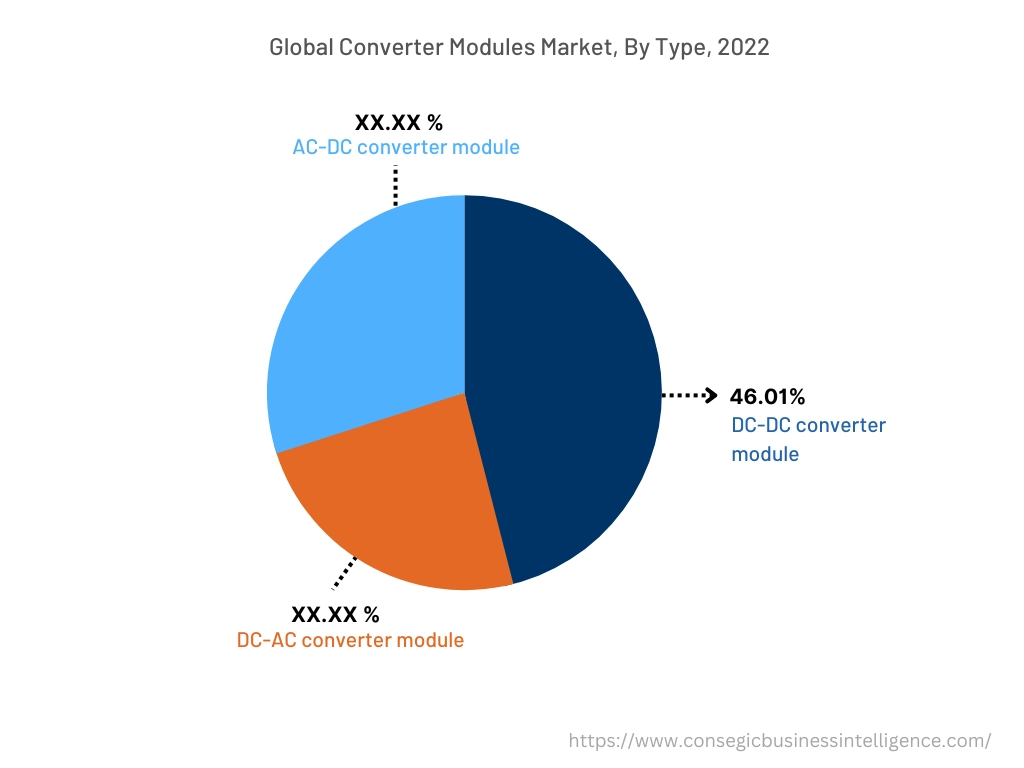
By End-User :
Based on the end-user, the market is segregated into IT & telecommunication, healthcare, transportation, aerospace & defense, and others. The IT & telecommunication segment accounted for the largest revenue share in the year 2022. Factors including the growing deployment of 5G infrastructure, expansion of data centers, and increasing demand for high speed communication and cloud services are driving the growth of the IT & telecommunication segment.
For instance, Murata Manufacturing Co., Ltd. offers DC-DC converter modules designed for application in telecommunication industry in its product portfolio. The DC-DC converter modules are designed for addressing the rising power requirements of high-reliability networking and telecommunications infrastructure equipment.
Additionally, according to Viavi Solutions Inc., the overall number of cities globally with 5G deployments reached 1,947 as of January 2022, along with the addition of 635 new 5G cities in 2021. Hence, the growth of IT & telecommunication industry is driving the adoption of converter modules for application in 5G base stations, data centers, and advanced communication systems, in turn driving the growth of the market.
Aerospace & defense segment is expected to witness fastest CAGR growth during the forecast period. The growth of aerospace & defense segment is attributed to several factors including rising commercial flight activities, increasing aircraft production, and rising investments in defense vehicles among others.
Converter modules are used in the aerospace & defense sector for providing efficient power distribution, superior power system performance, and connectivity from multiple unregulated power sources to the point of load.
For instance, Vicor Corporation offers a wide range of DC-DC converter modules including MIL-COTS DCM, MI-200/MI-J00 DC-DC converter modules, and others for application in aerospace & defense industry among others. Additionally, TDK Corporation provides various DC-DC converter modules for aerospace & defense applications in its product portfolio. Thus, rising development of converter modules for utilization in aerospace & defense applications is projected to drive the market growth during the forecast period.
By Region :
The regional segment includes North America, Europe, Asia Pacific, Middle East and Africa, and Latin America.
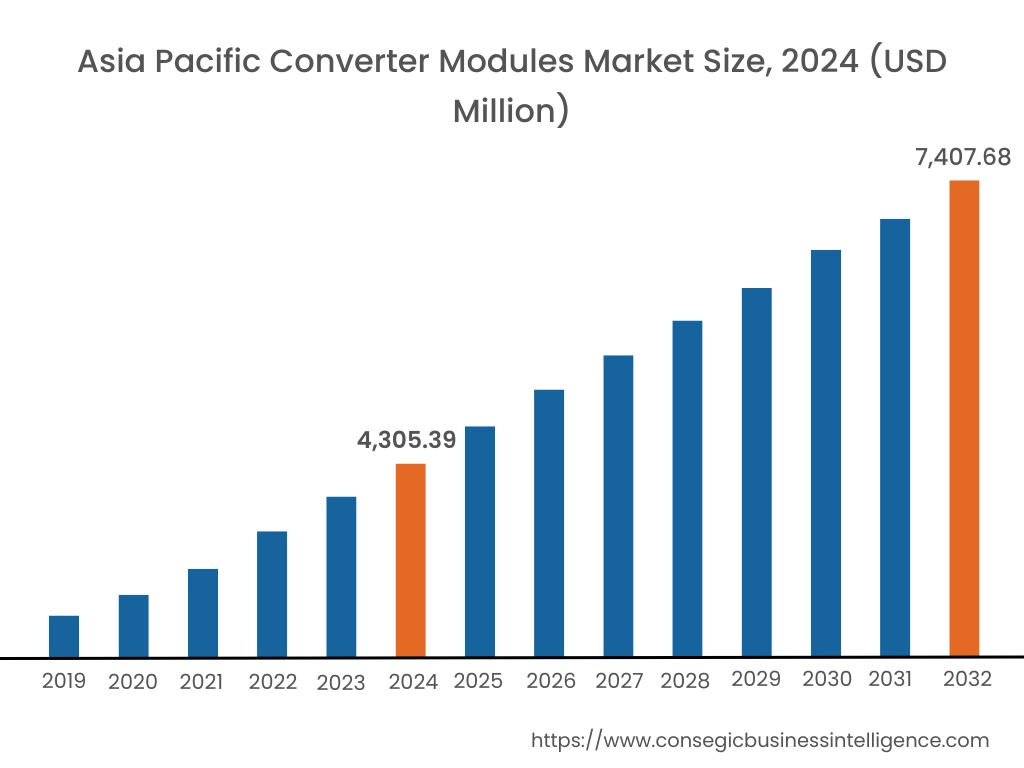
Asia-Pacific accounted for the largest revenue share of USD 3,980.87 Million in 2022 and USD 4,144.08 in 2023 and is expected to reach USD 6,851.19 Million by 2031, registering a CAGR of 6.1% during the forecast period. In addition, in the region, China accounted for the maximum revenue share of 30.10% in the same year. The market growth for converter modules in the Asia-Pacific region is primarily driven by its deployment in IT & telecommunication, aerospace & defense, transportation, and other sectors. Moreover, the growing IT & telecommunication industry and increasing utilization of converter modules in 5G base stations, data centers, and advanced communication systems are among the significant factors driving the market growth in the region.
For instance, according to the Department of Telecommunication of India, the total deployment of 5G base stations across India reached 324,192 units as of August 2023, depicting a substantial growth of over 100% from 53,590 base stations in January 2023. Thus, the growth of IT & telecommunication industry is boosting the deployment of converter modules, in turn accelerating market growth in the Asia-Pacific region. In addition, growing investments in the field of electric vehicles are anticipated to facilitate lucrative growth prospects for the market in Asia-Pacific during the forecast period.
Europe is expected to register a CAGR growth of 6.3% during the forecast period. The increasing pace of industrialization and development is promoting growth aspects for the market in the region. In addition, factors including the growth of various industries including healthcare, transportation, aerospace & defense, and others are driving the market growth for converter modules in the European region.
For instance, according to the European Medical Technology Industry, the medical device sector in Germany accounted for 25.8% of the total share of the medical device industry Europe in 2021, followed by France with 14.3%, UK with 10.4%, Italy with 9.0%, and Netherlands with 6.4% among others. Therefore, the growing medical sector in the European region is anticipated to drive the utilization of converter modules for improved voltage and current regulation in medical devices, thereby, proliferating market growth in the region during the forecast period.
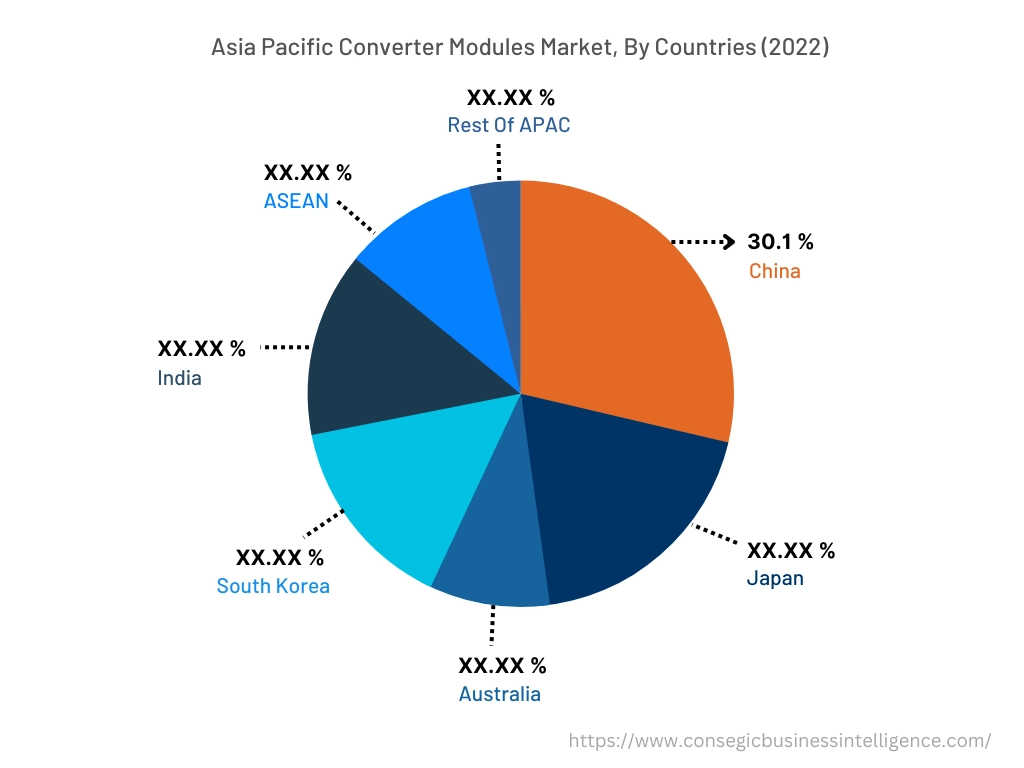
Top Key Players & Market Share Insights:
The converter modules market is highly competitive with major players providing converter modules to the national and international markets. Key players are adopting several strategies in research and development (R&D), product innovation, and end-user launches to hold a strong position in converter modules market. Key players in the converter modules market include-
- Delta Electronics Inc.
- STMicroelectronics
- RECOM Power GmbH
- TDK Corporation
- Vicor Corporation
- Renesas Electronics Corporation
- Texas Instruments Incorporated
- ABB Ltd.
- Flex Ltd.
- Murata Manufacturing Co. Ltd
Recent Industry Developments :
- In March 2022, TDK Corporation launched its new series of μPOL DC-DC converter modules integrated with smallest available size, increased performance, ease of utilization, and simplified integration. The DC-DC converter modules are designed for applications including big data, artificial intelligence (AI), 5G cells, telecommunication, computing enterprise, and other related applications.
Key Questions Answered in the Report
What is converter modules? +
Converter modules refers to electrical devices that are designed for converting electricity from one form to another or to particular values of current and voltage for the target device.
What specific segmentation details are covered in the converter modules report, and how is the dominating segment impacting the market growth? +
For instance, by type segment has witnessed DC-DC converter module as the dominating segment in the year 2022, owing to its increasing utilization in IT & telecommunication, aerospace & defence, automotive, and healthcare industries among others.
What specific segmentation details are covered in the converter modules market report, and how is the fastest segment anticipated to impact the market growth? +
For instance, by end-user segment has witnessed aerospace & defence as the fastest-growing segment during the forecast period due to rising adoption of converter modules for power conversion application to provide stable and reliable voltage to aircraft power systems.
Which region/country is anticipated to witness the highest CAGR during the forecast period, 2023-2031? +
Europe is anticipated to register highest CAGR growth during the forecast period due to rapid pace of industrialization and growth of multiple industries such as healthcare, automotive, aerospace & defence, and others.
